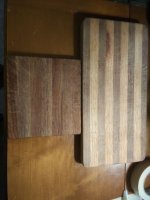usernumber1
Member
- Joined
- Aug 7, 2018
- Messages
- 467
I think it comes down to looks nowadays. The endgrain look might be too intense for some, depending how it's finished, if there's any pattern and which wood was used. You do have some design options if you use more than one species with patterns.
Sidegrain is most common since you can just buy countertops premade at ikea or homedepot that's what everyone is used to . they redefined the word definition of 'butcher block' in the process.
For finish I would recommend osmo topoil. it's designed for countertops and is food safe. If you are using it for cutting then just mineral oil. Another option is 50:50 pure tung oil:citrus solvent
Sidegrain is most common since you can just buy countertops premade at ikea or homedepot that's what everyone is used to . they redefined the word definition of 'butcher block' in the process.
For finish I would recommend osmo topoil. it's designed for countertops and is food safe. If you are using it for cutting then just mineral oil. Another option is 50:50 pure tung oil:citrus solvent

